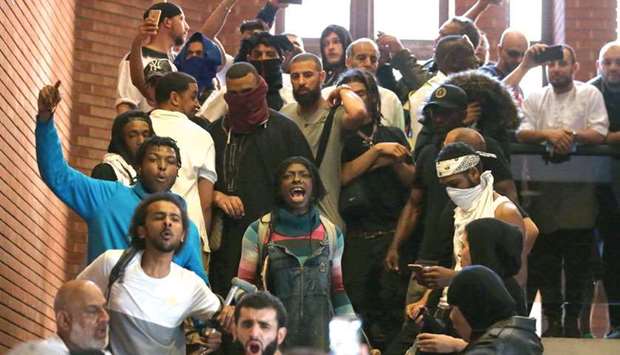A total of 58 people are presumed dead after the devastating fire in a London tower block, police chief Stuart Cundy told reporters yesterday.
“We’ve worked tirelessly to establish how many people we believe were in Grenfell Tower on the night and at this point in time we are unable to say that they are safe or well,” he said.
“There are 58 people who we have been told were in Grenfell Tower on the night that are missing and therefore, sadly, I have to assume that they are dead.”
Of the 58, he said the number of confirmed fatalities in Wednesday’s inferno remains at 30. Cundy said 16 bodies had so far been recovered from the tower and taken to a mortuary.
Police do not expect to find any survivors inside the 24-storey concrete tower, which contained 120 apartments.
On the figure of 58, he said: “I really hope it won’t, but it may increase,” while adding that “it might be that some of those are safe and well”, and for some reason, had not yet made themselves known to the police.
“Our focus has been on those that we know were in Grenfell Tower. However, there may be other people who were in there on the night that others were not aware were there,” he said.
“That is also an absolute priority for the investigation — to establish who they may be,” he added. Cundy said police had now managed to get to the top of the tower and had undertaken a first visual search for victims, ahead of later painstaking searches.
“There is considerable damage within Grenfell Tower,” he said.
“We have colleagues in there as we speak, searching for and recovering those that have died.”
The first victim to be formally identified was Mohamed Alhajali, a 23-year-old Syrian refugee, who came to Britain in 2014 with his brother. Cundy gave Alhajali’s name at the press briefing.
Alhajali, who lived on the 14th floor, was a civil engineering student at West London University.
The manufacturer of the panels used to clad the London tower block where at least 30 people died in a fire this week advised customers against using its polyethylene-cored tiles — the ones reportedly used at Grenfell Tower — in high rise buildings.
Diagrams in a brochure dated 2016 for Reynobond tiles reviewed by Reuters show how polyethylene (PE) core tiles are suitable only for buildings of up to 10m in height.”As soon as the building is higher than the fire fighters’ ladders, it has to be conceived with an incombustible material,” the brochure says.
The brochure was issued by French-based Arconic Architectural Products, which is responsible for the marketing in Europe of systems produced by US company Arconic, which owns Reynobond.
The Guardian and the BBC have reported in recent days that panels with a PE core were used in a refurbishment of the 24-storey tower bock that was completed last year.
Construction company Rydon Group, which undertook the work, and the local authority which owns Grenfell Tower declined to confirm whether the panels were PE.
Arconic did not respond to requests for comment.
Rydon had earlier said the revamp “met all required building control, fire regulation and health and safety standards”. Other diagrams in the Reynobond brochure show that panels with a fire retardant core — the FR model, according to Arconic’s website — can be used for buildings of up to 30 metres tall.
Above that height, it says, panels with a non-combustible core — the A2 model — should be used. Grenfell Tower is over 60 metres tall.
Documents submitted in 2015 by the local authority’s property division to its planning division seeking approvals for the refurbishment said the concrete and brick building would be clad in Reynobond insulation panels.
John Cowley, director of Omnis Exteriors which supplied the padding for the refurbishment but did not install it, told the Guardian that the company had been asked to supply the Reynobond PE variant.
The newspaper said the PE panels were 2 pounds ($2.56) cheaper per square metre than the Reynobond FR option.
Reuters has not been able to confirm independently whether the PE panels were ultimately used or whether the use of PE-core panels is legal in Britain.
Fire safety experts say polyethylene is generally avoided in tall buildings as it has been linked to a number of rapidly spreading fires at skyscrapers in Dubai and elsewhere.
“Polyethylene is a thermoplastic material, which...melts and drips as it burns, spreading the fire downwards as well as upwards,” architectural consultants Probyn Miers said in a note on insulation materials posted its website.
Witnesses to Wednesday’s blaze said the flames spread quickly up the building, which was left a charred shell.
The London Fire Brigade has yet to say what the cause of the fire was.
Building regulations documents did not specifically say PE-core panels should not be used, but three industry experts interviewed by Reuters said that did not mean builders were clearly permitted to use them.
That is because British safety regulations across many industries are usually principles- rather than rules-based.
This means the law often requires companies to act safely without giving a specific definition of what this would involve, said Christopher Miers of Probyn Miers.
Firms are instead expected to be able to prove in court that they behaved in a way that their industry would consider safe, given current knowledge and technology, these experts added.

Protesters call for a response from council officials inside Kensington Town Hall.


